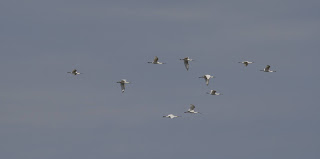Frampton Marsh, 8th August 2020
On a bright and sunny day, with a fresh breeze blowing, Natty and I headed to Lincolnshire to join my old friend Brian at Frampton Marsh, the RSPB's fantastic, relatively new and expanding, reserve beside the Wash in Lincolnshire.
 |
| Spoonbills, and a Moorhen. |
Here we were greeted near immediately by a flock of 17 or so Spoonbills, a sight which would have been unheard of just a few years ago, another brilliant white heron-like wetland bird establishing, or perhaps reestablishing itself, in British wetlands. The birds largely kept their spoons concealed, tucked under wings out of the sun and wind. The flashes were covered in Knot, Dunlins, Black Tailed Godwits, the latter in all plumages from tango orange to ash-grey, as though dressed for the summer.'s funeral. Among the waders Brian picked out a couple of Curlew Sandpipers, smart, dunlin-like waders with bold supercilliums.
 |
| Spotted Redshanks |
We continued to enjoy a veritable late summer wader fest, with so many returning migrants from the far North and East, graceful Spotted Redshanks in their near white winter coats, so different in their movements to their commoner cousins, Common and Green Sandpipers, and a very smart Greenshank, his head nearly pure white. The breeding waders remained too, graceful, long-legged Avocets, brown patches on their wings revealing them to be the very same awkward, gangly chicks hiding from the rain among their parents' breast feathers just a few short weeks ago.
 |
| Whooper Swan and Common Tern |
Shelducks floated about in their eclipse plumage, and a single Whooper Swan which had stayed the summer, perhaps too injured to make it across the North Sea though capable of flying back and forth across the reserve, lounged on an island in one of the freshwater lakes. The Spoonbill flock flew over, magnificent face spatulas forward, out towards the Wash.
 |
| Spatulas to the horizon! |
There was not an overabundance of passerines, as one would expect at this time of year, with so many lying low to moult and enjoy the richness of the season, but yellow wagtails, in their muddy looking winter plumage, were active around the cattle, and a few swifts zipped about. Swallows and Sand Martins were ubiquitous. Emperor Dragonflies patrolled the ponds, and Common Darters the paths, while Small Tortoiseshell butterflies fed at the Scabious blooms.
 |
| Common Blue Damselfly |
Frampton is an incredibly special place. You should go there.
 |
| Small Tortoiseshell |
Birds Seen: Brent Goose, Canada Goose, Greylag Goose, Mute Swan, Whooper Sean, Shelduck, Mallard, Teal, Pochard, Tufted Duck, Pheasant, Little Grebe, Great Crested Grebe, Spoonbill, Grey Heron, Little Egret, Cormorant, Moorhen, Coot, Avocet, Lapwing, Golden Plover, Little Ringed Plover, Whimbrel, Black Tailed Godwit, Knot, Ruff, Curlew Sandpiper, Dunlin, Snipe, Common Sandpiper, Green Sandpiper, Redshank, Spotted Redshank, Greenshank, Black Headed Gull, Common Gull, Herring Gull, Lesser Black Backed Gull, Common Tern, Stock Dove, Woodpigeon, Swift, Kestrel, Magpie, Rook, Carrion Crow, Skylark, Sand Martin, Starling, Yellow Wagtail, Pied Wagtail, Meadow Pipit, Linnet, Goldfinch, Reed Bunting.
 |
| Black tailed Godwit |
Butterflies: Red Admiral, Meadow Brown, Gakekeeper, Small Skipper, Common Blue, Small Heath, Small Tortoiseshell, Green Veined White.
 |
| Ruff |
 |
| Cinnabar moth caterpillars were numerous at Frampton. |
Coombes Valley, 9th August 2020
Of a warm but slightly overcast afternoon I went to Coombes Valley, in Staffordshire. It was surprisingly quiet, with few of the special birds out and about, perhaps down to the advancing season. However it was pretty, though a family insisted upon throwing pebbles into the stream where they Grey Wagtails breed. At least they were not building cairns and diverting the flow of water in the stream. Such disturbance in a habitat so small can have serious implications for its invertebrate diversity. A wasp was busy on the wood of the small bridge.
 |
| Wasp. |
I walked the Valley Woodland Loop, as the map called the circular footpath I wandered, and was surprised by the beautiful sight of three Red Deer- young stags- making their way among the trees. Each wore small, but different antlers in velvet. Deer often make their way through the woods at Coombes, but are seldom seen.
 |
| Freaky doll stuck to a Silver Birch tree. |
I picked up what my map called the 'Woodcock Trail' and was surprised to find Ling Heather, Calluna vulgaris once again, growing as an understory plant alongside Bilberry, Vaccinium myrtilis, as these species grow in much of their European range, but here associated with open heath and moor. I also enjoyed commanding views of the valley and the wider Stafforshire moorlands. Someone had stuck a small plastic doll to a tree.
The day ended with a spectacular orange sunset.
Birds Seen: Sparrowhawk, Buzzard, Woodpigeon, Kestrel, Magpie, Carrion Crow, Coal Tit, Blue Tit, Swallow, Willow Warbler, Garden Warbler, Goldcrest, Nuthatch, Treecreeper, Blackbird, Song Thrush, Spotted Flycatcher, Robin, Bullfinch.
Butterflies Seen: Peacock, Gatekeeper, Green Veined White.









